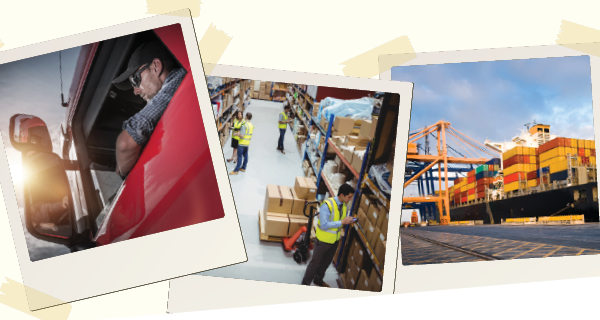2018: A Year to Remember

Most Likely to Have Lasting Impact
The new NAFTA
“The rules of origin for several industries will change. Revisit eligibility to claim NAFTA or USMCA duty rates in the future and perform a comprehensive rules of origin and regional value content analysis for every product.”
With the United States-Mexico-Canada Agreement (USMCA), don’t expect major shifts in how North American supply chains are managed. Trade among the three countries should be robust, and the outcome should be a win-win-win for all parties involved as global corporations are expected to continue to invest in North America.
Commerce has evolved since NAFTA was created and the trade agreement will reflect the world we live in today, not 25 years ago. This new agreement will provide clarity around the future of North American trade and allow shippers to properly prepare for capital investments and supply chain changes. Some sectors and products—such as automotive, dairy, eggs, and poultry—will likely be impacted more than others.
Amazon effect and consumer impatience extend to B2B
The Amazon effect continued to extend well past retailers in 2018. As business-to-business customers become accustomed to order status updates from their consumer experiences, they expect them in the business environment, as well. This impacts manufacturer priorities as companies examine how their systems and processes can meet new expectations for communication and speed. Better, faster, smarter is no longer a luxury—it’s a requirement.
The need for speed is also spawning a new category of last-mile delivery entrepreneurs that rely on ever-evolving technology to find new and affordable ways to deliver products quickly to consumers and businesses. Whether new models that rely on crowdsourced drivers for delivery are sustainable, however, remains to be seen.
3PLs remain valued partners
Shipper demands, customer expectations, and third-party logistics (3PL) capabilities are increasing as the supply chain is pushed to the forefront, notes the 2018 Third-Party Logistics Study. This comes as shippers continue to refocus efforts on their core strengths and rely more on 3PL providers.
At the same time, 3PL growth in 2018 has been fueled by implementing technology that allows for enhanced fulfillment capabilities, efficient supply chains, and data that can help shippers improve operations in their own organizations as well as for clients. This is due in part to the fact that total logistics expenditures as a percentage of sales revenues have increased, reaching 11 percent in the 2018 study from 10 percent in the previous year.
Most Popular
Capacity shortage
With the first quarter of 2018 representing the largest shortage in history, the ongoing truckload capacity crunch is the result of what insiders call the “perfect storm.” Factors range from a booming economy that’s producing more goods that need transporting to fewer trucks available because of recession-triggered fleet reductions a decade ago.
In addition, with the average age of the commercial truck driver at 55, more are retiring at the same time that companies struggle to attract younger talent to a profession that has lost its appeal.
As a result, many shippers are changing how they do business to make sure they have the capacity they need. Emerging efforts to help include developing technology that helps match carriers and drivers with goods, especially on backhauls.
Finding labor
With the U.S. unemployment rate averaging 3.9 percent during the first three quarters of 2018, and hitting a record low of 3.7 percent in September heading into the busy holiday fulfillment season, the labor shortage has affected all aspects of the supply chain. It’s not limited to warehouses having trouble finding seasonal employees—manufacturers and trucking companies need more help, too.
The workforce shortage is forcing all segments of the supply chain to be more resourceful with recruiting, whether it’s locating new fulfillment centers in more populated areas so there’s greater access to talent, offering more competitive wages and flexible hours, or attempting to attract drivers through TV ads.
ELD mandate
The electronic logging device (ELD) mandate that went into effect at the end of 2017 and limits the number of hours a driver can be on the road has had a notable impact on truckload capacity. Considering the driver shortage, placing limits on the existing workforce, while appropriate, exacerbated the problem.
The industry is addressing the driver shortage in a number of ways, including actively recruiting military veterans with driving experience, being more flexible with warehouse pickup and delivery times so drivers can avoid rush-hour congestion, and lobbying for improved infrastructure and more highway rest areas with room for tractor-trailers.
China tariffs
In 2018, President Trump used tariffs to deliver on a campaign promise to crack down on what he describes as years of unfair trade practices between the United States and China. The tariffs on Chinese imports included a 25-percent fee on nearly $50 billion in goods during the summer while September brought a 10 percent tariff on $200 billion in goods. The lower fall percentage, intended to reduce the impact on holiday demand, will increase to 25 percent on January 1, 2019. While November brought talk of a truce in the trade war, companies continue to feel the impact.
Chinese exporters aren’t the only ones affected; U.S. businesses are feeling it as well. More than half of American companies were affected by the tariffs with China, finds AsiaInspection’s mid-year survey. That number increases to nearly two-thirds of small and mid-sized businesses. As a result, many companies are continuing to shift some sourcing away from China.
Trendsetters
New trade agreements
“The EU-Japan Economic Partnership Agreement is set to create a free-trade relationship that covers about one-third of global GDP.”
I’ve long said that even in a world of Brexit and anti-trade sentiment in the United States, free trade agreements will quietly continue to proceed at the bilateral, regional, and global level—because they are needed.
And 2018 seemed to bear that out.
Emerging Asia is rallying even without the United States. The Regional Comprehensive Economic Partnership (RCEP), a proposed free-trade agreement between countries in the Asia Pacific region that together account for almost 40 percent of the world’s GDP, is expected to be agreed to before the end of 2018.
Naturally, we can’t ignore the U.S.-China trade dispute, which is worrisome on many levels. It’s likely that the face-off between the world’s two biggest economies will see higher prices for U.S. consumers, an economic hit for China, and a squeeze for European manufacturers with heavy capital expenditure investments in China and market exposure in the United States.
Weather, natural disasters, strikes
It has never been more important for manufacturers, shippers, and carriers to have a supply chain risk management plan. With NASA and other sources reporting that climate change is making hurricanes stronger and more intense, supply chain stakeholders still reeling from 2017’s devastating hurricane season had to expect more of the same in 2018.
Every significant natural disaster, whether Hurricane Florence in September or Indonesia’s recent earthquake and tsunami, affects the global supply chain. Non-weather disruptions that include Brazil’s spring labor strike and significant changes in trade deals—think Brexit—also mean that players know they must prepare for a range of potential disruptions.
Stars of the Future
Artificial intelligence
“Examples are variability in supplier delivery patterns based on seasonal changes, or how we can proactively avoid, for example, low inventory based on economic indicators, or avoid capacity shortages by constantly monitoring patterns in all the internal and external data.”
Supply chain planning systems are no longer just pre-defined optimization algorithms relying on a static model of the world. Nowadays, systems can constantly monitor tens of millions of variables that constitute the supply chain model, recognize hidden patterns, and generate correlations or causations not readily apparent to humans.
Today, most vendors are focused on use of machine learning in demand-planning technology; i.e. how systems can learn from results of past policies to produce improved forecasts. However, on the supply side, there are increasing opportunities to identify hidden gems in the supply chain that result in more accurate models and proactive decisions to avoid risk.
Blockchain
In 2018, blockchain brought new energy to the conversation around supply chain data sharing, which lacked a sense of urgency for many years. While it remains to be seen whether blockchain is as widely applicable as speculated, the barrage of pilot programs this year have helped clarify its potential for specific use cases, including food traceability and product authentication. The launch of IBM Food Trust and Walmart’s new requirement for some suppliers to use blockchain are key indicators that this technology is moving at an unprecedented pace.
While blockchain discussions and implementations are moving fast, it’s not a shortcut. To achieve the optimal level of data sharing between organizations, companies need to adopt standards that enable systems interoperability and data accuracy. Technology providers and piloting companies have discovered these are indispensable prerequisites to blockchain’s success. Without standards-based collaboration, we risk creating immutable blockchains that are simply faster at sharing bad data.
Time Capsule: Hallmarks of the Year
“2018 will be known as the year of the driver. In 2018, electronic logging devices (ELD) highlighted the importance of drivers and their relationships with shippers.”
Thanks to the strongest truckload shipping market since deregulation, demand outstripped the supply of trucks, and drivers didn’t have to take on the costs of the ELD mandate as predicted. Drivers passed along costs to shippers to compensate for the lost flexibility of hours of service and inefficiencies in dwell times at load and drop sites.
In turn, shippers focused more on creating strong relationships with drivers on their docks and worked to get them back on the road as quickly as possible.
“In my opinion, 2018 will go down as the year of innovation. Significant automation in almost every aspect of supply chain management is driving significant operational change and operating efficiency.”
Many international transportation management third-party logistics providers and domestic transportation management/freight brokerage (DTM) operations have deployed Lanetix CRM for logistics to better manage projects and request for proposal processes. Machine learning is being utilized to automate back-office document processing in DTM operations with applications such as HubTran. In addition, visibility solutions are streamlining shipment status communications among shippers, carriers, and DTMs.
The price of using autonomous robots in warehousing has decreased to a point where they are becoming more commonplace in operations over and beyond just Amazon. Artificial intelligence solutions are making significant inroads into DTM 3PL operations and are enabling the automation of reading and extracting information from emails and matching loads to carriers.
“With efficiency, transportation costs are rising to a boardroom-level issue. You may have noticed a growing trend on earnings calls where companies reference increased transportation costs as a reason for missing profitability targets. Any chance to gain efficiency in the supply chain has now become a top priority. A key area of focus for improving efficiency and driving down costs includes optimizing modes, networks, and routes. Artificial Intelligence and machine learning support efficiency by recommending optimizations and automating manual tasks.”
2018 will be known for its visibility and efficiency. Visibility into load transit times and potential delays is more important than ever. Shippers are anxious to get their loads covered, and carriers are placing greater importance on working with ‘shippers of choice’ who can ensure drivers get loaded, unloaded, and back on the road as quickly as possible. Visibility helps uncover inefficiencies, including identifying facilities that have longer-than-average wait times so solutions can be implemented.







